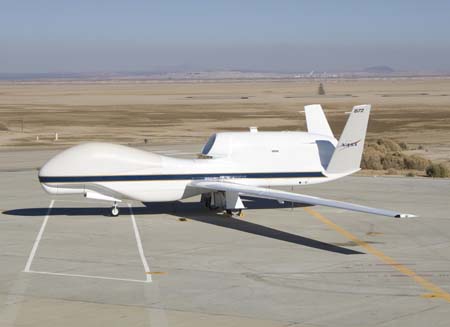NASA and the Nor throp Grumman yesterday unveiled the first of two RQ-4 Global Hawk unmanned aerial vehicles that the agency will fit with special instruments for use starting later this year in high-altitude environmental science research. The rollout took place at NASA’s Dryden Flight Research Center in Edwards AFB, Calif. “The Global Hawks will provide superb new measurement possibilities for our climate science and applications programs,” said Michael Freilich, director of NASA’s Earth Science Division. The two Global Hawks are former Air Force assets from the seven original demonstrator flight vehicles. NOAA is partnering with NASA to exploit these new airborne tools. NASA plans six long-duration missions over the Pacific and Arctic regions beginning in the late spring. (NASA release)
throp Grumman yesterday unveiled the first of two RQ-4 Global Hawk unmanned aerial vehicles that the agency will fit with special instruments for use starting later this year in high-altitude environmental science research. The rollout took place at NASA’s Dryden Flight Research Center in Edwards AFB, Calif. “The Global Hawks will provide superb new measurement possibilities for our climate science and applications programs,” said Michael Freilich, director of NASA’s Earth Science Division. The two Global Hawks are former Air Force assets from the seven original demonstrator flight vehicles. NOAA is partnering with NASA to exploit these new airborne tools. NASA plans six long-duration missions over the Pacific and Arctic regions beginning in the late spring. (NASA release)
The rate of building B-21 bombers would speed up if the fiscal 2026 defense budget passes. But it remains unclear how much capacity would be added, and whether the Air Force would simply build the bombers faster, or buy more.
